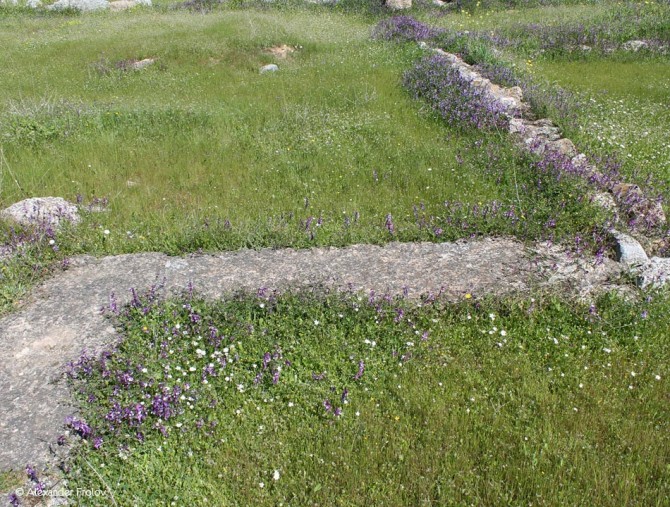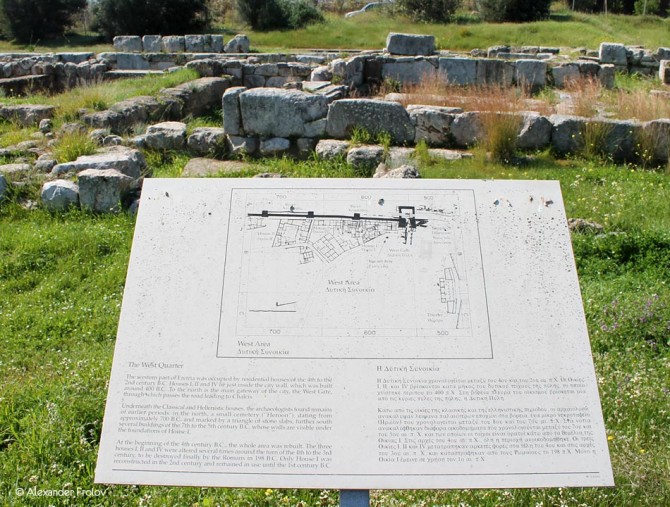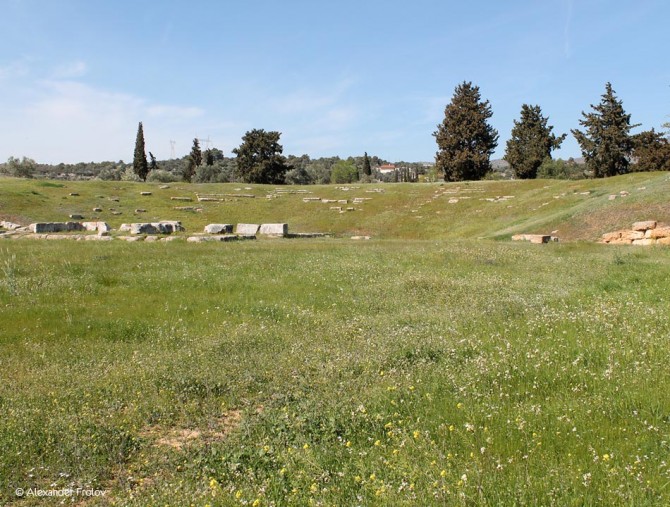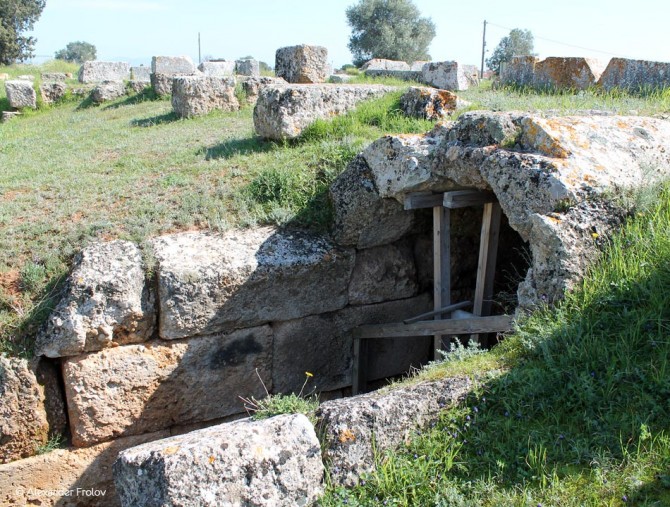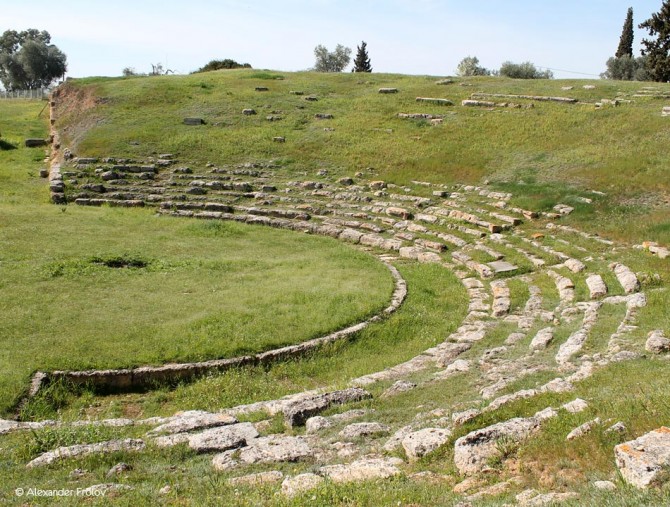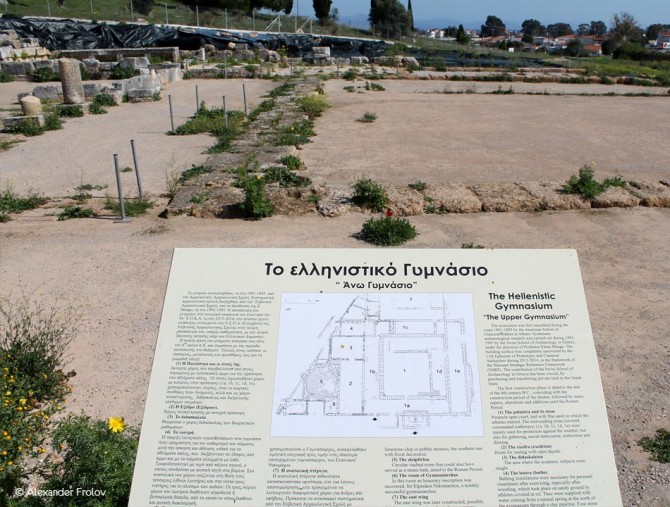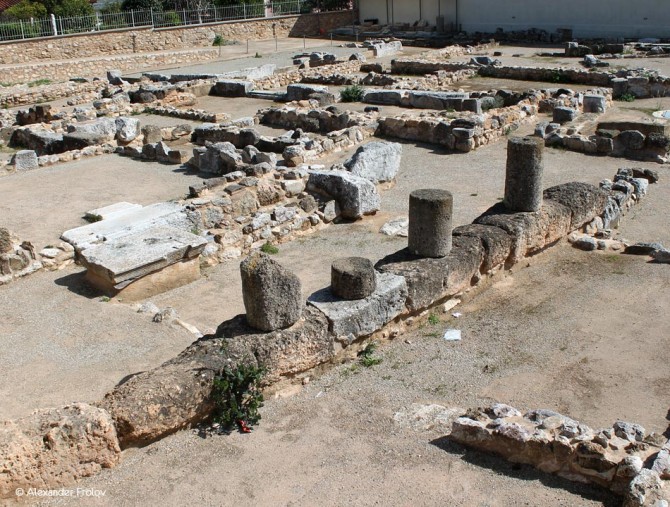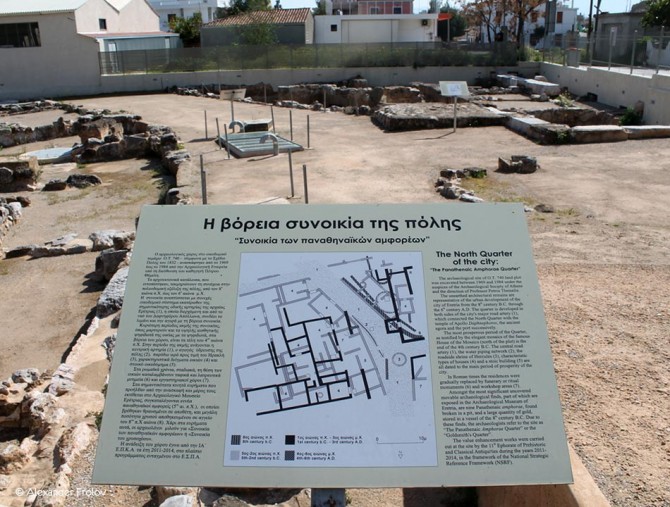Археологические раскопки Эретрии
Два самых влиятельных древних полиса античных времен острова Эвбея – это Халкида и Древняя Эретрия. Эретрия уже в VIII веке до н.э. была мощным военно-морским городом-государством с колониями на Эгейском побережье, островах и даже на Сицилии. В переводе название города означает "город гребцов", что свидетельствует о том, что жители города занимались мореплаванием.
Первые следы обитания в этом районе датируются концом неолита, о чем свидетельствуют найденные тут несколько фрагментов глиняной посуды. Что интересно – эти находки указывают на контакты жителей Эгейского моря и севера. Тем не менее, первое значительное поселение здесь появилось в ранне и среднеэлладский периоды между храмом Аполлона Дафнефороса и агорой. От той эпохи до наших дней сохранилось несколько зданий. Также археологи в этом районе обнаружили артефакты микенского периода.
Как мы уже говорили – расцвет Древней Эретрии начался в VIII веке до н.э., когда город был переведен на территорию Агоры (рынка), а территория внутри микенской крепости была занята святилищами. Могущество Эретрии не могло не волновать жителей Халкиды, которая по развитию была равной ей – из-за этого между полисами в конце VIII века до н.э. развязалась война, которую принято называть "лелантская". Несмотря на то, что Эретрия в этой войне потерпела поражение – на ее развитии и могуществе это никак не сказалось.
В конце VI века до н.э. Древняя Эретрия начинает выпускать собственную валюту и появляется новая демократическая конституция. В последующие годы город помог Милету в бунте против персов (494 год до н.э.), участвовал на стороне греков в морском сражении при Артемисии и Саламине (480 г. до н.э.), в конфликте при Платеях (479 год до н.э.) и Первом Афинском Альянсе годом позднее. В 411 году до н.э. Эретрия сбрасывает афинскую гегемонию и город переживает новый экономический бум. В этот период тут укрепляются оборонительные сооружения, появляются новые жилые дома. Именно тогда в Эретрии появился театр.
Расцвет города продолжался и после знаменитой битвы при Хиронии в 338 году до н.э., когда полис стал принадлежать македонцам. В это время крепостные стены стали еще мощнее, появилось множество таких общественных построек, как стадион и гимнасий, а театр приобрел свою окончательную форму. Закат города начинается в 198 году до н.э. с приходом римлян, которые нанесли Эретрии весомые разрушения.
Современный город Эретрия не сильно хорош в эстетическом плане, хотя то тут, то там на глаза и попадаются неоклассические постройки. Зато останки древнего полиса можно встретить тут чуть ли не на каждом шагу. В местном археологическом музее можно увидеть немало любопытных артефактов из истории города. Совсем неподалеку от музея расположено сразу несколько археологических сайтов. Это останки храма Аполлона Дафнефороса, Агора, Дом мазаик (репрезентативной образец классической и эллинистическогой архитектуры), Древний Толос (круглое здание V века до н.э. на территории Агоры), македонская сводчатая Гробница Эрота, покрытая курганом) и замечательный Античный театр, который был построен в V веке до н.э. и имеет немало общего с Театром Диониса в Афинах.
Часы работы археологического сайта Древней Эретрии:
8:00-15:00, ежедневно, вход свободный.
Как добраться до археологического сайта Древней Эретрии:
- на машине из Эретрии (12,2 км) по ул. Македонияс
До Эретрии:
- на машине из Афин (105 км) по трассе Е75/А1
- на машине из Салоник (484 км) по трассе Е75
- на машине из Халкиды (31,8 км) по трассе Е044
- на автобусе из Афин с автовокзала Лиссион
Автовокзал Эретрии, тел.: +30 22290 61 602
- на пароме из Оропуса (до него на машине из Афин по трассе афины-Ламия)
Паром ходит каждые 30 мин в период с апреля по октябрь с 7:00 по 22:00 (понедельник-четверг), 7:00-22:30 (пятница), 7:30-22:30 (суббота, воскресенье)
Цена билета на паром: 2 евро за человека, 8 евро за автомобиль
Продолжительность: 30 мин.
Тел. порта Эретрии: +30 2290 64 990
Тел. порта Оропуса: +30 22950 37 270
Фото и текст: Александр Фролов
The Archaeological Site of Eretria
The Ancient Eretria along with the Ancient Chalkis were the two powerful cities of Euboea. In fact Eretria was a very powerful naval city since the 8th century BC, with many colonies in the Aegean coasts, the islands and the Magna Graecia (as the territories of the various ancient Greek colonies in Sicily and the southern Italy were known).
The first traces of habitation in the area are dated in the late Neolithic Era, which were actually just a few pottery fragments that indicate the contacts of the inhabitants with the Aegean Sea and the North. However, the first significant settlement was developed during the Early Helladic and the Middle Helladic period in the area between the Temple of Apollo Daphnephoros and the subsequent city’s agora (market), but also on the citadel. From this era, only a few building remains are still preserved. The archaeologists also found a few remnants from the Mycenaean Era, showing the inhabitants’ high standard of living at this period.
However, as we have already mentioned, the Ancient Eretria’s blooming began in the 8th century BC. Around this time, the city core was transferred to the agora, while the area of the fortified Mycenaean citadel was occupied by the sanctuaries. The Ancient Eretria began to build colonies, increasing its power. The expansion of Eretria in all directions worried the equal powerful Chalkis, and led the two cities into the known Lelantine War at the end of the 8th century BC. Although Eretria was defeated, the city’s blooming did not stop.
At the end of the 6th century BC, the Ancient Eretria cut its own currency, adopted the democratic constitution and became even more powerful. In the following years, it helped Miletus to revolt against the Persians (494 BC), participated alongside the Greeks at the naval battles of Artemisium (480 BC) and of Salamis (480 BC) and the conflict of Plataea (479 BC) and participated in the First Athenian Alliance (478 CB), always against the Persians. In 411 BC, however, the Ancient Eretria threw off the Athenian hegemony and recovered economically. At this period, the city walls were strengthened, and new houses and imposing public buildings were constructed, such as the theater.
The Eretria’s blooming was continued also after the battle of Cheronia (338 BC), when the Macedonians dominated the city. At this time, the city walls were strengthened even more, more magnificent private and public buildings were built, such as the gymnasium and the stadium, while the theater got its final form. The decline of the city, however, began in 198 BC, when it was dominated by the Romans who destroyed it.
Today, the modern Eretria is dotted with the remnants of the glorious ancient city. Especially in the area around the very interesting Archaeological Museum of Eretria, you will see the archaeological sites of the Western and the South districts of the ancient city (with the foundations of imposing mansions of the very distant past), the magnificent temple of Apollo Daphnephoros, the Ancient Theatre, which was built in the 5th century BC and presented many similarities to the theatre of Dionysos in Athens, the House with the Mosaics (a representative specimen of the Classical and Hellenistic domestic architecture), the Ancient Tholos (a circular building which was erected in the 5th century BC in the Agora of the city) and the Macedonian Tomb of Erotes (Macedonian vaulted tomb made of local poros stone, covered by an earthen tumulus).
Archaeological Site of Eretria, nearby the Archaeological Museum of Eretria, Eretria, Euboea. Visiting hours: 01 Jun – 31 Oct Mon-Sun, 08:00-15:00. 01 Nov – 31 May Mon-Sun, 08:00-15:00. Free entrance.
How to get there: By car from Eretria (distance 12,2 km) via Makedonias street. You can get to Eretria by car from Athens (distance 105 km) via Α/Δ ΠΑΘΕ/E75/Α1, from Thessaloniki (distance 484 km) via E75 and from Chalkida (distance 31,9 km) via EO44. By bus: Liossion Bus Station (200 Liossion Avenue, Athens), tel.: +3 0 210 83 22 997. Eretria Bus Station, tel.: +30 22290 61 602. By Ferry from Oropus (coming from Athens. follow the National Road Athens-Lamia, and turn the output on Oropus). Monday to Thursday: 07:00, 07:30, 08:00, 08:30, 09:00, 09:30, 10:00, 10:30, 11:00, 11:30, 12:00, 12:30, 13:00, 13:30, 14:00, 14:30, 15:00, 15:30, 16:00, 16:30, 17:00, 17:30, 18:00, 18:30, 19:00, 19:30, 20:00, 20:30, 21:00, 22:00. Friday: 07:00, 07:30, 08:00, 08:30, 09:00, 09:30, 10:00, 10:30, 11:00, 11:30, 12:00, 12:30, 13:00, 13:30, 14:00, 14:30, 15:00, 15:30, 16:00, 16:30, 17:00, 17:30, 18:00, 18:30, 19:00, 19:30, 20:00, 20:30, 21:00, 21:30, 22:00, 22:30. Saturday: 07:30, 08:00, 08:30, 09:00, 09:30, 10:00, 10:30, 11:00, 11:30, 12:00, 12:30, 13:00, 13:30, 14:00, 14:30, 15:00, 15:30, 16:00, 16:30, 17:00, 17:30, 18:00, 18:30, 19:00, 19:30, 20:00, 20:30, 21:00, 21:30, 22:00, 22.30. Sunday: 07:30, 08:00, 08:30, 09:00, 09:30, 10:00, 10:30, 11:00, 11:30, 12:00, 12:30, 13:00, 13:30, 14:00, 14:30, 15:00, 15:30, 16:00, 16:30, 17:00, 17:30, 18:00, 18:30, 19:00, 19:30, 20:00, 20:30, 21:00, 21:30, 22:00, 22:30. Ticket price: 2 euros/ per person, 8 euros / driver and car. The trip by ferry lasts 30 minutes. Eretria Port, tel.: +30 2290 64 990. Oropus Port, tel.: +30 22950 37 270
Τext: Marilou Pantazi


